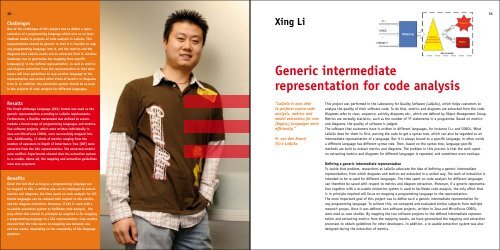Software Technology - Stan Ackermans Institute - TU/e
Software Technology - Stan Ackermans Institute - TU/e
Software Technology - Stan Ackermans Institute - TU/e
Create successful ePaper yourself
Turn your PDF publications into a flip-book with our unique Google optimized e-Paper software.
30<br />
Challenges<br />
One of the challenges of this project was to define a repre-<br />
sentation of a programming language which acts as an inter-<br />
mediate media in projects of code analysis in LaQuSo. This<br />
representation should be generic so that it is feasible to map<br />
any programming language into it, and the metrics and the<br />
diagrams that LaQuSo needs can be extracted from it. Another<br />
challenge was to generalise the mapping from specific<br />
language(s) to the defined representation, as well as metrics<br />
and diagram extraction from the representation so that deve-<br />
lopers will have guidelines to map another language to the<br />
representation and extract other kinds of metrics or diagrams<br />
from it. In addition, the extraction system should be re-used<br />
in the projects of code analysis for different languages.<br />
Results<br />
The Graph eXchange Language (GXL) format was used as the<br />
generic representation according to LaQuSo requirements.<br />
Furthermore, a flexible metamodel was defined to accom-<br />
modate a broad range of programming languages and metrics.<br />
Two software projects, which were written individually in<br />
Java and MicroFocus COBOL, were successfully mapped into<br />
GXL. Additionally, 13 kinds of metrics ranging from the<br />
number of operators to Depth of Inheritance Tree (DIT) were<br />
extracted from the GXL representation. The extracted metrics<br />
were verified. Experiments showed that the extraction system<br />
is re-usable. Above all, the mapping and extraction guidelines<br />
were also proposed.<br />
Benefits<br />
Given the fact that as long as a programming language can<br />
be mapped to GXL, a uniform way can be employed to extract<br />
metrics and diagrams, the time spent on code analysis for dif-<br />
ferent languages can be reduced with respect to the metrics<br />
and the diagram extraction. Moreover, if GXL is used with a<br />
re-usable extraction system to facilitate code analysis, the<br />
only effort that should in principle be required is for mapping<br />
a programming language to a GXL representation. Case studies<br />
showed that the time spent on mapping was between one<br />
and two weeks, depending on the complexity of the language<br />
grammar.<br />
Xing Li<br />
Generic intermediate<br />
representation for code analysis<br />
“LaQuSo is now able<br />
to perform source code<br />
analysis, metrics and<br />
model extraction for new<br />
(legacy) languages more<br />
efficiently.”<br />
M. van den Brand,<br />
<strong>TU</strong>/e LaQuSo<br />
This project was performed in the Laboratory for Quality <strong>Software</strong> (LaQuSo), which helps customers to<br />
analyse the quality of their software code. To do that, metrics and diagrams are extracted from the code.<br />
Diagrams refer to class, sequence, activity diagrams etc., which are defined by Object Management Group.<br />
Metrics are normally statistics, such as the number of ‘if’ statements in a programme. Based on metrics<br />
and diagrams, the quality of software is judged.<br />
The software that customers have is written in different languages, for instance C++ and COBOL. What<br />
LaQuSo does for them is: first, parsing the code to get a syntax tree, which can also be regarded as an<br />
intermediate representation of a language. But it is always bound to a specific language, in other words<br />
a different language has different syntax tree. Then, based on the syntax tree, language-specific<br />
methods are built to extract metrics and diagrams. The problem in this process is that the work spent<br />
on extracting metrics and diagrams for different languages is repeated, and sometimes even overlaps.<br />
Defining a generic intermediate representation<br />
To tackle that problem, researchers at LaQuSo advocate the idea of defining a generic intermediate<br />
representation, from which diagrams and metrics are extracted in a united way. The work of extraction is<br />
intended to be re-used for different languages. The time spent on code analysis for different languages<br />
can therefore be saved with respect to metrics and diagram extraction. Moreover, if a generic representation<br />
together with a re-usable extraction system is used to facilitate code analysis, the only effort that<br />
is in principle required will focus on mapping a programming language to the representation.<br />
The most important goal of this project was to define such a generic intermediate representation for<br />
any programming language. To achieve this, we compared and evaluated similar subjects from multiple<br />
research groups. Once it was defined, two software projects, written in Java and MicroFocus COBOL,<br />
were used as case studies. By mapping the two software projects to the defined intermediate representation<br />
and extracting metrics from the mapping results, we have generalised the mapping and extraction<br />
processes to obtain guidelines for other developers. In addition, a re-usable extraction system was also<br />
designed during the extraction of metrics.<br />
31



